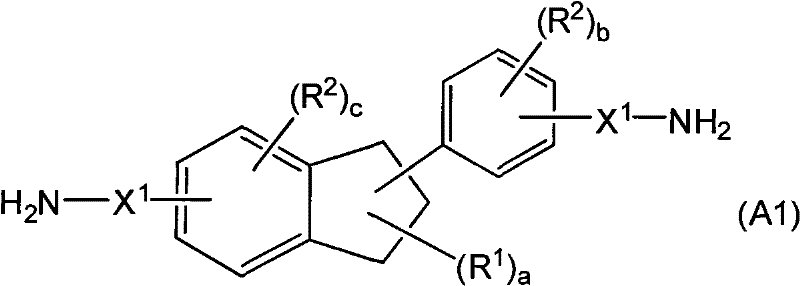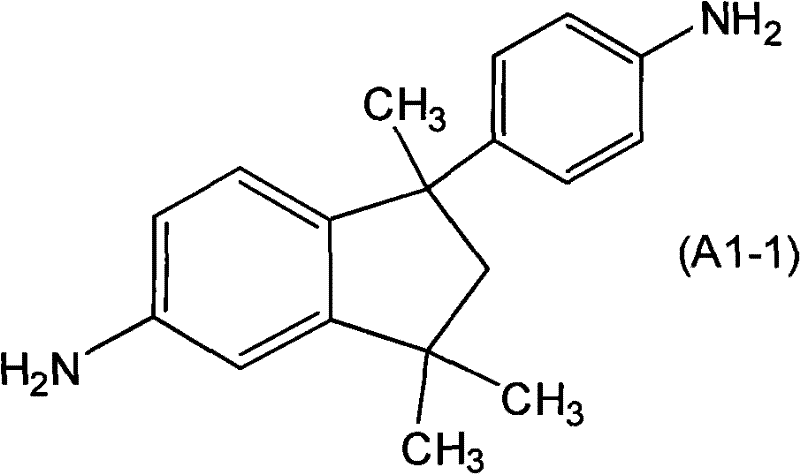Liquid crystal aligning agent, liquid crystal alignment layer, liquid crystal display element, polyamide acids and polyimides
A technology of liquid crystal alignment agent and polyamic acid, which is applied in liquid crystal materials, instruments, optics, etc., can solve problems such as insufficient peelability, achieve excellent display quality, reduce the probability of bad coatings, and have excellent peelability
- Summary
- Abstract
- Description
- Claims
- Application Information
AI Technical Summary
Problems solved by technology
Method used
Image
Examples
Synthetic example J-1
[0214] 220g (1.0mol) of 2,3,5-tricarboxycyclopentylacetic dianhydride as tetraacid dianhydride and 3-(2,4-diaminophenoxy) of 49g (0.1mol) as diamine Cholesterane, 53g (0.2mol) of 1-(4-aminophenyl)-2,3-dihydro-1,3,3-trimethyl-1H-inden-5-amine (the above formula (A1- 1) the compound shown), 54g (0.2mol) of the compound shown in the above formula (A2-2-1), and 99g (0.5mol) of 4,4'-diaminodiphenylmethane dissolved in 1,900g of N- In methyl-2-pyrrolidone (NMP), it was made to react at 60 degreeC for 6 hours, and the solution containing a polyamic acid was obtained. The obtained polyamic acid solution was fractionated in a small amount, and the measured solution viscosity was about 1,400 mPa·s.
[0215] Next, 2,400 g of NMP was added to the obtained polyamic acid solution, and 120 g of pyridine (corresponding to 1.5 mol with respect to the amic acid unit contained in 1 mol of the above-mentioned polyamic acid) and 153 g of acetic anhydride (with respect to the above-mentioned polya...
Synthetic example J-2~J-17
[0217] In addition to the above Synthesis Example J-1, the types and amounts of tetraacid dianhydride and diamine used as raw material monomers and the amount of pyridine and acetic anhydride in the dehydration ring-closure reaction (relative to the amide that each polyamic acid has Moles of the number of moles of the acid units) are as described in Table 1, respectively, and in the same manner as the above-mentioned Synthesis Example J-1, polyimides (I-2) to (I-10) and polyimides (I-2) to (I-10) and Solutions of (II-1) to (II-7).
[0218] Table 1 shows the viscosity of the polyamic acid solution during the synthesis of these polyimide solutions and the imidation rate of the obtained polyimide.
[0219] In addition, synthesis examples J-11 to J-17 are comparative synthesis examples.
[0220] 【Table 1】
[0221]
[0222] In Table 1, the abbreviations of the raw material monomers have the following meanings, respectively, and "-" indicates that the raw material monomer corr...
Synthetic example P-1
[0243] [Synthesis of Polyorganosiloxane Having Epoxy Group]
[0244] In a reaction vessel with a stirrer, a thermometer, a dropping funnel and a reflux condenser, add 99 g of 2-(3,4-epoxycyclohexyl) ethyl trimethoxysilane as a silane compound, 500 g of Methyl isobutyl ketone and 10 g of triethylamine as a catalyst were mixed at room temperature. Next, after adding 100 g of deionized water dropwise over 30 minutes from the dropping funnel, it was reacted at 80° C. for 6 hours while stirring under reflux. After the reaction was completed, the organic layer was taken out, washed with 0.2% by weight of ammonium nitrate aqueous solution until the washed water was neutral, and the solvent and water were distilled off under reduced pressure to obtain polyorganosiloxane with epoxy groups, as Viscous transparent liquid.
[0245] The hydrolyzed condensate 1In H-NMR analysis, a peak due to the epoxy group of theoretical intensity was obtained around chemical shift (δ) = 3.2 ppm, and i...
PUM
| Property | Measurement | Unit |
|---|---|---|
| viscosity | aaaaa | aaaaa |
| viscosity | aaaaa | aaaaa |
| thickness | aaaaa | aaaaa |
Abstract
Description
Claims
Application Information
 Login to View More
Login to View More - R&D
- Intellectual Property
- Life Sciences
- Materials
- Tech Scout
- Unparalleled Data Quality
- Higher Quality Content
- 60% Fewer Hallucinations
Browse by: Latest US Patents, China's latest patents, Technical Efficacy Thesaurus, Application Domain, Technology Topic, Popular Technical Reports.
© 2025 PatSnap. All rights reserved.Legal|Privacy policy|Modern Slavery Act Transparency Statement|Sitemap|About US| Contact US: help@patsnap.com



